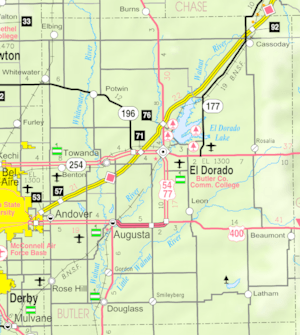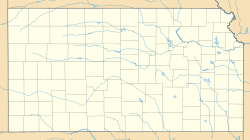Plum Grove, Kansas facts for kids
Quick facts for kids
Plum Grove, Kansas
|
|
|---|---|

|
|
| Country | United States |
| State | Kansas |
| County | Butler |
| Township | Plum Grove and Milton |
| Named for | Plum bushes |
| Population | |
| • Total | 0 |
| Time zone | UTC-6 (CST) |
| • Summer (DST) | UTC-5 (CDT) |
| Area code | 620 |
Plum Grove was once a small town, often called a ghost town, in Butler County, Kansas, United States. It was located in a quiet, rural area. Today, you won't find any buildings there, as it has become farmland. The town was named after the many plum bushes that grew nearby.
Contents
History of Plum Grove
Starting the Town
A post office named Plum Grove opened on July 1, 1870. It was in northwest Butler County, Kansas. The person who owned the land and ran the post office was John R. Wentworth. He named the post office after the many plum bushes growing near his home. This first location was by the East Branch of the Whitewater River. It was near where NW 110th Street and NW Buffalo Road are today. Over the next two years, some businesses started in Plum Grove.
Hopes for a Railroad
On October 7, 1872, people in the county voted to fund a new railroad. This railroad was planned to go through the Whitewater River valley. The route was going to be close to Plum Grove. So, the small community decided to move about 1.5 miles (2.4 km) west. This move was to make sure the town would be right next to the future railroad.
Challenges and Decline
Sadly, a big money problem called the panic of 1873 stopped the railroad project. This was a setback for Plum Grove. But the town kept growing while it tried to get a train station. At its busiest, Plum Grove had about 60 to 100 people. It had several general stores, a drug store, a tree nursery, and a boarding house. There was also a blacksmith shop, a barn for horses, and a saw mill. The town even had its own community water well.
In the spring of 1885, a different railroad line was built. It went east and west a few miles south of Plum Grove. Again, a railroad did not go through Plum Grove. After this, the town started to shrink. Shop owners, houses, and people slowly moved away. They went to new towns nearby like Brainerd or Potwin. Some also moved to Whitewater and Peabody.
In 1887, another railroad was built about 5 miles (8 km) west of Plum Grove. This was the "final straw" for the town. The post office closed on October 31, 1888. Most of the town's land was empty by 1889.
Plum Grove Today
After the town disappeared, only the rural school remained. A new school building was built there in 1895. It served students until 1955, when it closed and the building was moved. The school's water well was filled in the late 1960s. This removed the last signs of Plum Grove. Today, the area where Plum Grove once stood is active farmland.
Location of Plum Grove
Plum Grove was located in northwest Butler County, Kansas. You can find its former spot at the modern-day intersection of NW 110th Street and NW Santa Fe Lake Road. This is about 3 miles (4.8 km) north and 1 mile (1.6 km) west of today's Potwin. It sits on the border between Plum Grove and Milton townships.
Education in the Area
The area around where Plum Grove used to be is now part of the Remington USD 206 public school district. The rural Frederic Remington High School is about 4 miles (6.4 km) south of the old Plum Grove site.
People Connected to Plum Grove
Daniel McCurdy Elder
Daniel McCurdy Elder (1844-1923) was a saw mill owner and operator. He had mills in Plum Grove and other places along the Whitewater River. He also owned a stone quarry. In 1889, he served as a representative in the Kansas House of Representatives.
Frederic Remington
Frederic Sackrider Remington (1861-1909) was a famous American Old West artist. For a time, he was also a sheep rancher. From 1883 to 1884, he owned a ranch north of Plum Grove. His ranch started at 160 acres and later grew to 320 acres. Many books say his ranch was near Peabody. This is because Peabody had the closest train station back then. He spent time in both communities. There is a monument dedicated to Remington at the nearby Frederic Remington High School.



